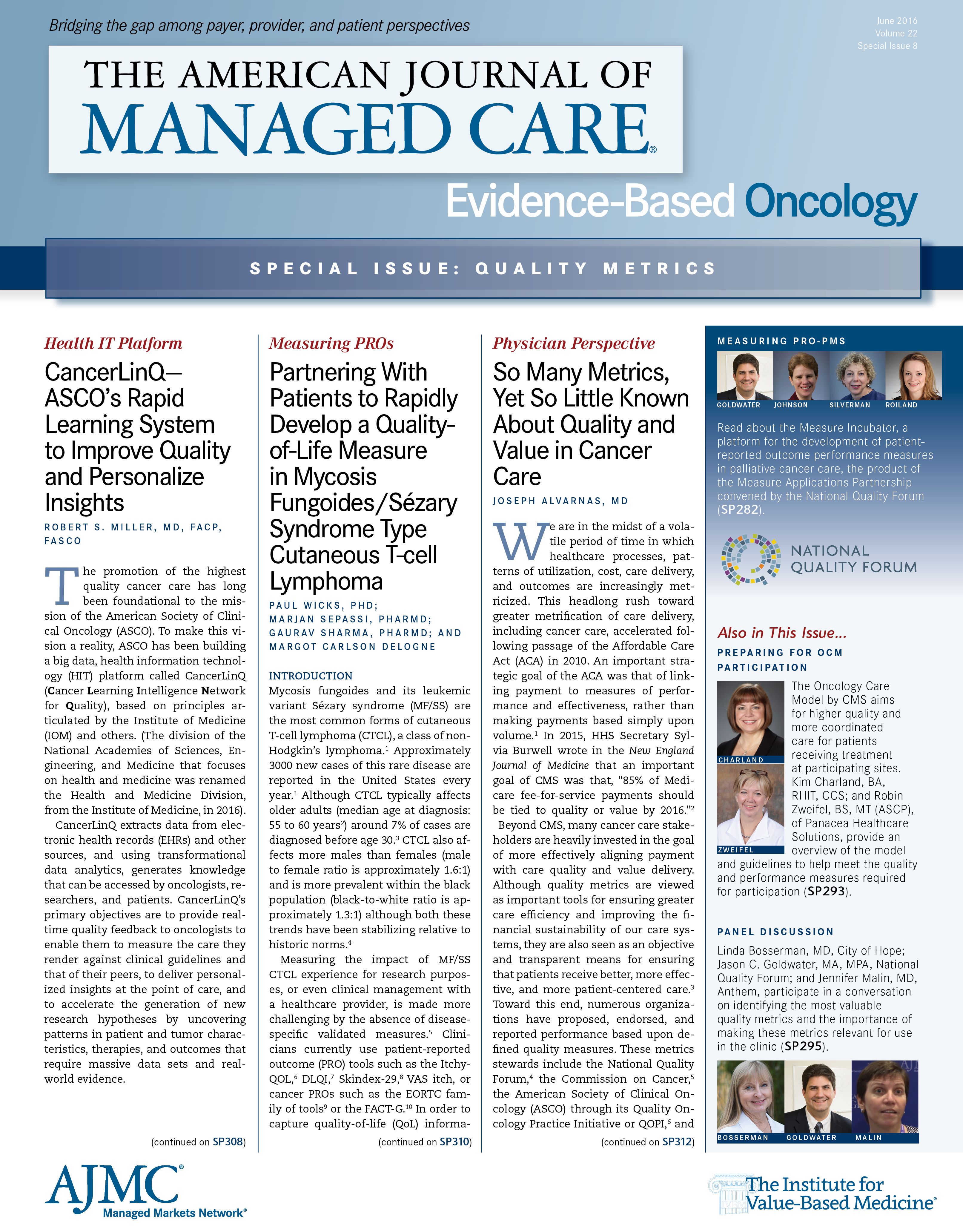- Center on Health Equity & Access
- Clinical
- Health Care Cost
- Health Care Delivery
- Insurance
- Policy
- Technology
- Value-Based Care
Surmounting the Quality Chasm in Healthcare
Despite the breadth of metrics, there seems to be a significant disconnect between the relatively prosaic, process-based measures that largely dominate our quality portfolio and the high-level, aspiration-driven demands of delivering increasingly complex care to patients with cancer.

In its 2001 report, Crossing the Quality Chasm: A New Health System for the 21st Century, the Institute of Medicine described 6 essential attributes of care that needed to be systematically applied in order to fundamentally transform healthcare for the better. These attributes included care that was safe, effective, efficient, equitable, patient-centered, and timely.1 Passage of the Affordable Care Act in March 2010 not only embedded these priorities into law, but also began the complex process of realigning economic incentives toward making this healthcare vision a reality.2 In this process, quality metrics have been stewarded by multiple healthcare stakeholders to ensure a transparent link between quality improvements in healthcare and resulting payment for performance enhancement.3,4
Despite the breadth of metrics, there seems to be a significant disconnect between the relatively prosaic, process-based measures that largely dominate our quality portfolio and the high-level, aspiration-driven demands of delivering increasingly complex care to patients in need of precision medicine and personalized cancer care solutions.5 This disconnect is no more acute than in the domain of cancer care, where advances in the state of the art of care far outpace our palate of quality measures and where our very limited capacity to abstract adequate clinical data from electronic health records (EHRs) has undermined the ambition, utility, importance, and effectiveness of our cancer care measures. This disconnect is further magnified by a paucity of patient-reported outcomes measures—meaningful outcomes measures like survival and time to recovery of patient function—and metrics that seek to discern and reward the development of better systems of care rather than reward effective care transactions.6
In this edition of Evidence Based Oncology, the challenges and opportunities for developing and deploying better cancer care quality measures are explored. More importantly, we also explore the question of how these measures coupled with innovative payment systems can lead to better systems of care. Jason Goldwater from the National Quality Forum (NQF) describes the NQF’s Measure Incubator, which is a platform for the development of better patient-reported outcome performance measures for palliative cancer care. Kim Charland and Robin Zweifel from Panacea Healthcare Solutions describe CMS’ Oncology Care Model, or OCM. The goal of this model is to better align economic incentives with physician practice quality initiatives in a longitudinal care model that seeks to improve financial and performance accountability for cancer patients. Dr Amit Gupta from HealthHelp describes a multidisciplinary, multidimensional model for improving decision support, enhancing cross-specialty care collaboration, and reducing care-related costs. Dr Robert Miller from the American Society of Clinical Oncology (ASCO) describes CancerLinQ. This is a proprietary ASCO big data platform for aggregating clinical data from EHRs for quality benchmarking, hypothesis generation, and empowering the development of more robust clinical metrics. Finally, we have a multi-stakeholder panel discussion regarding the challenges of developing better cancer care measurement and quality assessment tools.
EBO
Reference
The words “quality” and “value” are perhaps 2 of the most overused words when discussing the future evolution of cancer care. At times, they become clichés and catchphrases rather than tools for delivering more effective cancer care or creating better care delivery systems. By looking at quality metrics and cancer care value delivery more critically, we can make genuine steps toward realizing care systems and quality metrics that are worthy of the patients that we serve. Joseph Alvarnas, MD, is associate clinical professor and director of medical quality and quality, risk, and regulatory management, City of Hope, Duarte, CA.
1. Across the chasm: six aims for changing the health care system. Institute for Healthcare Improvement website. http://www.ihi.org/resources/pages/improvementstories/acrossthechasmsixaimsforchangingthehealthcaresystem. aspx. Accessed June 1, 2016.
2. Burwell SM. Setting value-based payment goals—HHS efforts to improve US health care. N Engl J Med. 2015;372(10):897-899. doi:10.1056/NEJMp1500445.
3. National Quality Forum website. http://www.qualityforum.org/Home.aspx. Accessed June 1, 2016.
4. Measures overview. ASCO Institute for Quality website. http://www.instituteforquality.org/ qopi/measures. Accessed June 1, 2016.
5. Geiger AM. Quality and precision medicine. Healthcare Delivery Research Program/National Cancer Institute website. http://healthcaredelivery.cancer.gov/blog/node/22. Accessed June 1, 2016. 6. Porter ME. What is value in health care? N Engl J Med. 2010;363(26):2477-2481. doi:10.1056/NEJMp1011024

Exploring Racial, Ethnic Disparities in Cancer Care Prior Authorization Decisions
October 24th 2024On this episode of Managed Care Cast, we're talking with the author of a study published in the October 2024 issue of The American Journal of Managed Care® that explored prior authorization decisions in cancer care by race and ethnicity for commercially insured patients.
Listen

